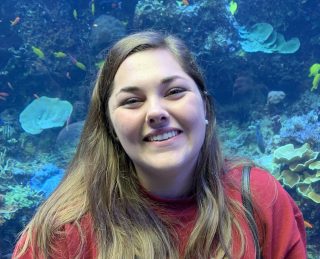Traducción al español a continuación.
This expedition is in collaboration with the Galápagos National Park, Charles Darwin Foundation, and the local navy, INOCAR.
Over a mile below the water’s surface in the western Galápagos spreading center, the seafloor is slowly spreading apart. Lava pushed up from Earth’s mantle cools and forms new ocean crust, pushing older crust away at a rate of 50 mm per year. Deep sea hydrothermal vents are often found near these seafloor spreading centers, and searching for new vents is one of the many scientific objectives of this expedition.
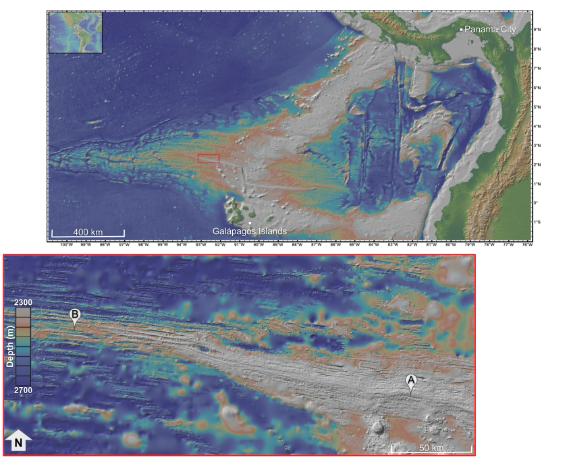
Since they were discovered in 1977 near the Galápagos Islands, hydrothermal vents have become intriguing and difficult places to find and explore. Life flourishes at and around deep sea hydrothermal vents, despite what creatures living at sea level would consider harsh conditions (high pressure, high temperatures, absence of light, strong chemical and pH gradients). The very existence of animals at hydrothermal vents challenges what we know about life. If we can understand how life persists in these extreme environments, we can speculate how extraterrestrial (and on Earth!) life evolved and exists.
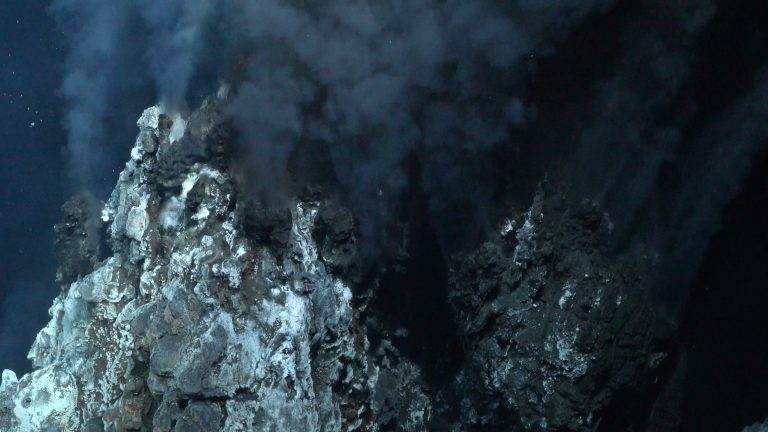
At seafloor spreading centers, cold seawater percolates through deep cracks within Earth’s crust, is superheated by geothermal sources, and undergoes continuous chemical modification from reactions with surrounding rock. The chemically-altered seawater, now called hydrothermal fluid, is heated to temperatures that can exceed 400℃. This hot fluid becomes buoyant and rapidly rises back to the seafloor. The billowing, black smoke characteristic of some vents, is enriched with dissolved natural chemicals, such as hydrogen sulfide and iron that are distinct from ambient seawater. As hydrothermal fluid escapes from the seafloor, it mixes with seawater diluting its physical and chemical characteristics. This process creates a hydrothermal plume that is dispersed and scattered by deep ocean currents. Researchers visited our study region in the western Galápagos spreading center over 15 years ago, and detected chemically distinct signals, indicating the presence of undiscovered hydrothermal vents.
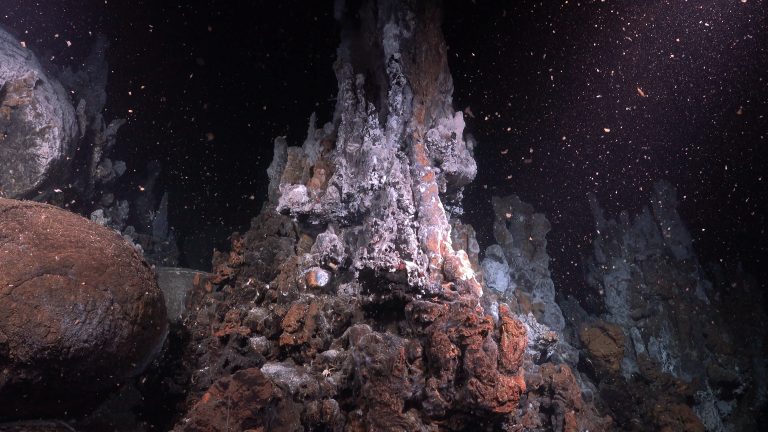
Searching for hydrothermal vents requires a combination of chemical and physical sensors, geologic intuition, skill, and luck. It is like looking for a 4-leaf clover in a patch of 3-leaf clovers. Bathymetric data (seafloor maps) can provide a roadmap that narrows the search for hydrothermal vents, but often a combination of physical measurements such as changes in chemical signatures, temperature and turbidity are the best tracers to track a fluid to its source.
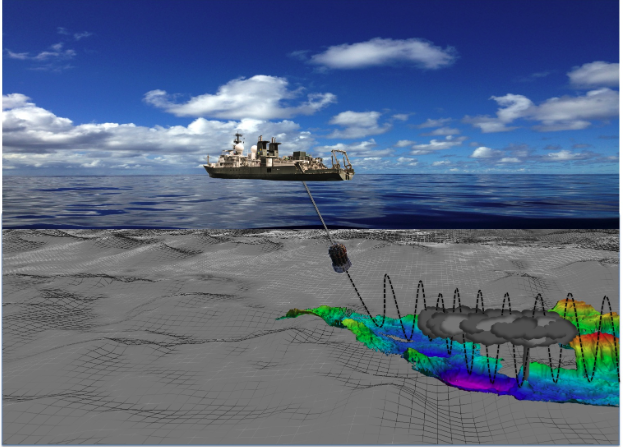
Scientists hunt for hydrothermal plumes in the deep ocean using a technique called the ‘Tow-Yo’, to discover new hydrothermal vents. A Tow-Yo involves a series of sensors attached to a wire that live-streams data to the ship. The sensors are lowered down to the seafloor, along with a rosette that secures water sampling bottles. The wire is then slowly towed from a moving vessel, while lowered and raised repeatedly (like a yo-yo), maximizing the area covered by our search. During the Tow-Yo operation, scientists monitor sensor data from a computer, looking for small changes in temperature, turbidity, and seawater chemistry (measured as redox potential). Slight increases in temperature, as little as 0.1 °C, increases in turbidity, and drops in redox potential are all indicators that a hydrothermal vent system is nearby. Scientists will make note of the location of these signals and send ROV SuBastian down to continue the search. Previously collected high-resolution maps will also be used to guide our dives while we create new maps to further investigate for undiscovered hydrothermal vents.
Buscando Fuentes Hidrotermales
A más de un kilómetro y medio por debajo de la superficie del agua en el centro de extensión occidental de las Galápagos, el lecho marino se está separando lentamente. La lava empujada desde el manto de la Tierra se enfría y forma nueva corteza oceánica, empujando la corteza más antigua a un ritmo de 50 mm al año. Las fuentes hidrotermales de aguas profundas suelen encontrarse cerca de estos centros de extensión del fondo marino, y la búsqueda de nuevas fuentes es uno de los muchos objetivos científicos de esta expedición.
Desde que se descubrieron en 1977 cerca de las islas Galápagos, las fuentes hidrotermales se han convertido en lugares intrigantes y difíciles de encontrar y explorar. La vida florece en y alrededor de las fuentes hidrotermales de aguas profundas, a pesar de lo que las criaturas que viven a nivel del mar considerarían condiciones duras (alta presión, altas temperaturas, ausencia de luz, fuertes gradientes químicos y de pH). La mera existencia de animales en las fuentes hidrotermales pone en tela de juicio lo que sabemos sobre la vida. Si somos capaces de entender cómo persiste la vida en estos entornos extremos, podremos especular sobre cómo evolucionó y existe la vida extraterrestre (¡y en la Tierra!).
En los centros de propagación del fondo marino, el agua de mar fría se filtra a través de grietas profundas de la corteza terrestre, se sobrecalienta por fuentes geotérmicas y sufre continuas modificaciones químicas por reacciones con la roca circundante. El agua de mar alterada químicamente, ahora denominada fluido hidrotermal, se calienta a temperaturas que pueden superar los 400℃. Este fluido caliente se vuelve flotante y asciende rápidamente hacia el fondo marino. El humo negro y ondulante característico de algunos respiraderos está enriquecido con sustancias químicas naturales disueltas, como el sulfuro de hidrógeno y el hierro, que son distintas del agua de mar ambiente. A medida que el fluido hidrotermal escapa del fondo marino, se mezcla con el agua de mar diluyendo sus características físicas y químicas. Este proceso crea una pluma hidrotermal que se dispersa y esparce por las corrientes oceánicas profundas. Los investigadores visitaron nuestra región de estudio en el centro de extensión occidental de las Galápagos hace más de 15 años y detectaron señales químicamente distintas, que indicaban la presencia de fuentes hidrotermales aún por descubrir.
La búsqueda de fuentes hidrotermales requiere una combinación de sensores químicos y físicos, intuición geológica, habilidad y suerte. Es como buscar un trébol de 4 hojas en una mancha de tréboles de 3 hojas. Los datos batimétricos (mapas del fondo marino) pueden proporcionar una hoja de ruta que acote la búsqueda de fuentes hidrotermales, pero a menudo una combinación de mediciones físicas, como los cambios en las firmas químicas, la temperatura y la turbidez, son los mejores rastreadores para seguir la pista de un fluido hasta su fuente.
Los científicos buscan plumas hidrotermales en las profundidades oceánicas mediante una técnica llamada “Tow-Yo”, para descubrir nuevos respiraderos hidrotermales. El Tow-Yo consiste en una serie de sensores conectados a un cable que transmite datos en directo al barco. Los sensores se bajan al fondo marino, junto con una roseta que sujeta las botellas de muestreo de agua. A continuación, el cable se remolca lentamente desde un buque en movimiento, mientras se baja y sube repetidamente (como un yo-yo), maximizando el área cubierta por nuestra búsqueda. Durante la operación Tow-Yo, los científicos controlan los datos de los sensores desde un ordenador, buscando pequeños cambios en la temperatura, la turbidez y la química del agua de mar (medida como potencial redox). Los ligeros aumentos de temperatura, de tan sólo 0,1 °C, los incrementos de turbidez y los descensos del potencial redox son indicadores de la proximidad de un sistema de ventilación hidrotermal. Los científicos tomarán nota de la ubicación de estas señales y enviarán el ROV SuBastian para continuar la búsqueda. También se utilizarán mapas de alta resolución recopilados previamente para guiar nuestras inmersiones mientras creamos nuevos mapas para seguir investigando en busca de respiraderos hidrotermales por descubrir.
Image 1: Mapa batimétrico del centro de extensión occidental de Galápagos. Los científicos centrarán su búsqueda de nuevas fuentes hidrotermales en las regiones menos profundas del centro de extensión (~2.300 metros), donde se forma la nueva corteza oceánica. *explicar el contorno del recuadro rojo
Image 4: SOI Image: https://schmidtocean.org/cruise-log-post/bonanza-on-the-back-arc/ Los científicos utilizan la técnica Tow-Yo para buscar plumas de fumarolas hidrotermales en aguas profundas. Durante un Tow-Yo, los sensores conectados a un cable se remolcan detrás de un buque y se bajan y suben cerca del fondo marino para detectar señales físicas y químicas de los penachos que emanan de los respiraderos. Las regiones coloreadas del fondo marino ilustran la cartografía del fondo marino que ayuda a guiar la búsqueda.
Un ejemplo de lo que buscamos: una fumarola hidrotermal negra humeante del Centro de Propagación de Galápagos Occidental. La nube de humo deja marcas químicas y físicas distintivas en la columna de agua, que es lo que buscamos con el Tow-Yo.




